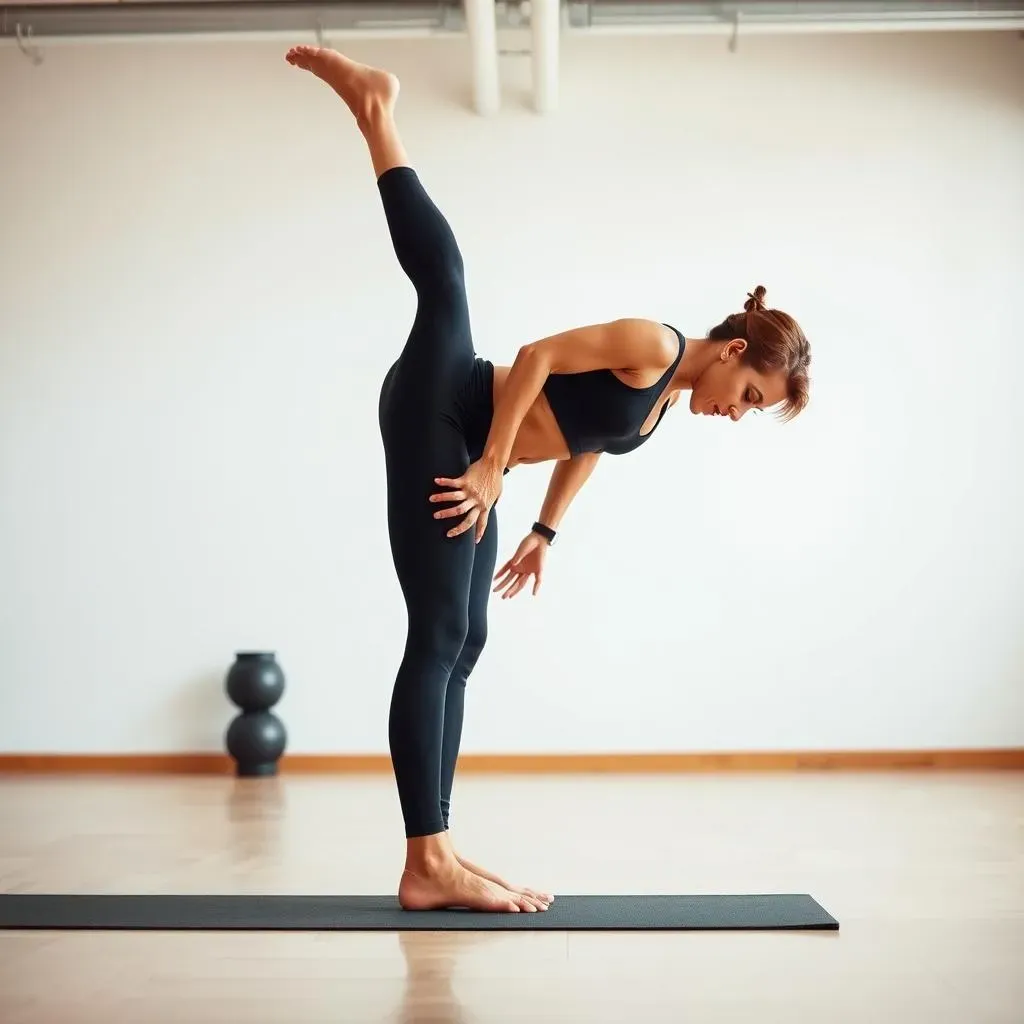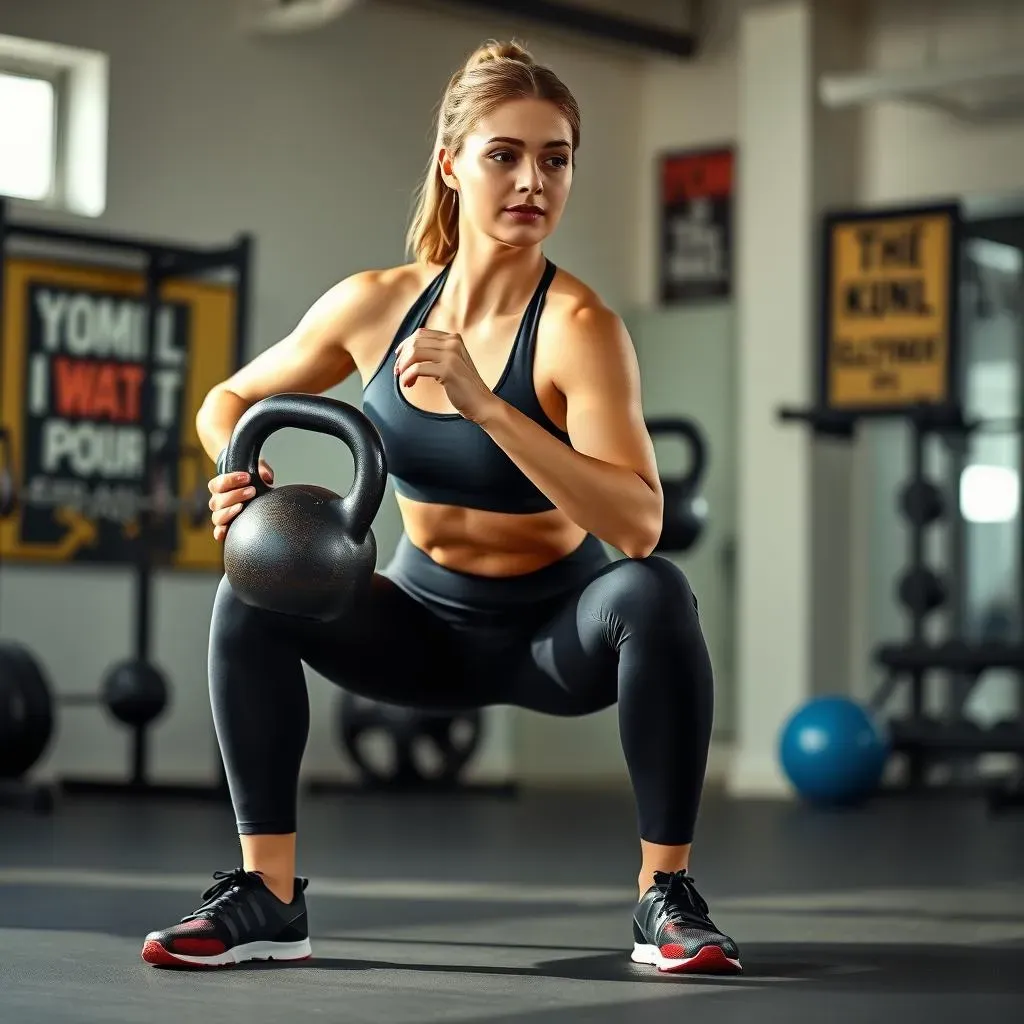Table of Contents
Ready to ditch the endless crunches and discover a more effective way to build a strong, sculpted core? Forget those complicated gym machines! With just a single kettlebell, you can unlock a powerhouse of easy kettlebell core exercises that will transform your midsection. This isn't about grueling workouts; it's about smart training that fits into your busy life. We'll start with the fundamental "vertical plank," a simple yet crucial posture that activates your core before you even pick up the kettlebell. Then, we'll dive into eight carefully selected exercises, from the Farmer's March to the Single-Arm Suitcase Deadlift, each designed to target specific core muscles and deliver maximum results. You'll learn proper form, modifications, and how to progress as you get stronger. Plus, we'll explore the incredible benefits of a strong core beyond just aesthetics – think improved balance, stability, and reduced risk of injury. So, whether you're a beginner or a seasoned fitness enthusiast, get ready to discover how easy kettlebell core exercises can help you achieve the core of your dreams!
Mastering the Vertical Plank: Your Foundation for Easy Kettlebell Core Exercises

Mastering the Vertical Plank: Your Foundation for Easy Kettlebell Core Exercises
Why the Vertical Plank? It's All About Core Activation
Before you even think about swinging a kettlebell, let's talk about the vertical plank. It's not your typical plank on the floor; this is a standing position that teaches you to engage your core correctly. Think of it as the "ready" position for all your kettlebell work. Why is this important? Because many people unknowingly use their lower back or other muscles to compensate when their core isn't properly engaged, which can lead to injury. The vertical plank wakes up your core, ensuring it's doing the work it's supposed to do during those easy kettlebell core exercises.
I remember when I first started with kettlebells, I jumped right into the exercises without focusing on core activation. Big mistake! My lower back was constantly sore, and I wasn't seeing the results I wanted. Once I incorporated the vertical plank into my warm-up, everything changed. My core felt more stable, my movements were more controlled, and my back pain disappeared.
How to Nail the Vertical Plank: Step-by-Step
let's break down how to do the vertical plank properly. It's simple, but attention to detail is key:
- Stand tall: Feet hip-width apart, knees slightly soft (not locked).
- Engage your glutes: Squeeze your butt muscles – this helps tilt your pelvis slightly and prevents an excessive arch in your lower back.
- Tuck your tailbone: Imagine you're trying to shorten the distance between your ribs and your hips. This is a subtle movement, not a big crunch.
- Pull your belly button towards your spine: This activates your deep core muscles (transverse abdominis).
- Maintain proper breathing: Breathe deeply into your belly, not your chest. Avoid holding your breath.
- Think tall: Imagine a string pulling you up from the crown of your head, maintaining good posture.
Hold this position for 30-60 seconds, focusing on maintaining proper form. You should feel your core muscles working, but you shouldn't feel any pain in your lower back. This isn't about holding your breath and bracing as hard as you can; it's about finding a gentle engagement that you can sustain. Now that you know how to engage your core, let see what easy kettlebell core exercises can do for you!
Common Mistakes and How to Fix Them
Even though the vertical plank seems simple, it's easy to make mistakes. Here are a few common ones and how to correct them:
- Arching the lower back: This puts unnecessary stress on your spine. Squeeze your glutes and tuck your tailbone to correct this.
- Holding your breath: This increases blood pressure and prevents proper core engagement. Focus on deep, diaphragmatic breathing.
- Locking your knees: This can lead to instability and knee pain. Keep your knees slightly soft.
- Rounding your shoulders: This indicates poor posture. Imagine a string pulling you up from the crown of your head and actively pull your shoulder blades down and back.
- Forgetting to engage the glutes: The glutes play a crucial role in stabilizing the pelvis. Squeeze them!
Practice the vertical plank in front of a mirror to check your form. It might feel awkward at first, but with practice, it will become second nature. Once you've mastered the vertical plank, you're ready to move on to the easy kettlebell core exercises that will sculpt your abs and strengthen your entire body.
8 Easy Kettlebell Core Exercises to Sculpt Your Abs

8 Easy Kettlebell Core Exercises to Sculpt Your Abs
Getting Started: Safety First and Kettlebell Selection
Alright, now for the fun part! Before we jump into the easy kettlebell core exercises, let's cover a couple of crucial things: safety and kettlebell selection. First off, make sure you have enough space to move freely without bumping into anything. A clear area of about 6x6 feet should do the trick. Listen to your body! If you feel any sharp pain, stop immediately. It's always better to err on the side of caution.
Choosing the right kettlebell weight is key. Start with a weight that allows you to maintain good form throughout the entire exercise. For most women, a good starting point is 8-12 kg (18-26 lbs), and for men, 12-16 kg (26-35 lbs). Don't be a hero! It's better to start lighter and gradually increase the weight as you get stronger. Remember, we're focusing on core engagement and control, not just lifting heavy weight. These easy kettlebell core exercises are most effective when performed with proper technique.
Here's a quick guide to help you choose the right kettlebell weight:
Experience Level | Recommended Weight (Women) | Recommended Weight (Men) |
|---|---|---|
Beginner | 8 kg (18 lbs) | 12 kg (26 lbs) |
Intermediate | 12 kg (26 lbs) | 16 kg (35 lbs) |
Advanced | 16 kg+ (35 lbs+) | 20 kg+ (44 lbs+) |
Exercise 1-4: Foundation Movements
Alright, let's dive into our first four easy kettlebell core exercises! Remember to maintain that vertical plank posture we talked about earlier throughout each movement. Focus on controlled movements and engaging your core with every rep.
- Farmer's March: Hold a kettlebell in each hand, stand tall, and walk forward. Focus on keeping your core tight and preventing excessive swaying. Aim for 30-45 seconds.
- Goblet High Hold: Hold the kettlebell close to your chest, stand tall, and actively pull your shoulders back and down. Engage your core throughout the exercise. Hold for 30-45 seconds.
- Goblet Squat: Holding the kettlebell in the goblet position (close to your chest), perform a squat, pushing your hips back and keeping your chest up. This adds a core challenge to a classic exercise. Aim for 8-12 reps.
- Archer Row: Stand with your feet shoulder-width apart, holding the kettlebell in one hand. Hinge at your hips, keeping your back straight, and row the kettlebell towards your chest, squeezing your shoulder blades together. This exercise targets your core and back muscles. Aim for 8-12 reps per side.
Exercise 5-8: Advanced Core Activation
Ready to kick things up a notch? These next four easy kettlebell core exercises will challenge your stability and core strength even further. Remember to focus on controlled movements and maintaining proper form.
Here are the next four exercises:
- Single-Arm Suitcase Deadlift: Stand with your feet hip-width apart, with a kettlebell on one side. Hinge at your hips, keeping your back straight, and pick up the kettlebell. This exercise forces your core to work hard to prevent you from tilting to one side. Aim for 8-12 reps per side.
- Strict Press: Stand with your feet shoulder-width apart, holding the kettlebell in the rack position (kettlebell resting on your forearm). Press the kettlebell overhead, keeping your core tight and your wrist straight. This exercise challenges your core stability and shoulder strength. Aim for 8-12 reps per side.
- Ipsilateral Dead Bug (Alternating): Lie on your back with your knees bent and feet off the ground, holding the kettlebell in one hand. Extend the opposite arm and leg simultaneously, keeping your lower back pressed against the ground. This exercise targets your deep core muscles and improves coordination. Aim for 8-12 reps per side.
- Hollow Body Hold: Lie on your back with your arms extended overhead and your legs straight. Press your lower back against the ground and lift your arms and legs slightly off the ground, creating a "hollow" shape with your body. This exercise is a great way to strengthen your entire core. Hold for 30-45 seconds.
Don't be afraid to modify these exercises if needed. For example, if you're having trouble with the Single-Arm Suitcase Deadlift, start with a lighter weight or perform the exercise with both feet on the ground. The key is to listen to your body and progress gradually. Remember, with these easy kettlebell core exercises, consistency is key!
Beyond Aesthetics: The RealWorld Benefits of a Strong Core

Beyond Aesthetics: The RealWorld Benefits of a Strong Core
More Than Just a Six-Pack: Unveiling the Core's True Purpose
Let's be honest, many people start core workouts chasing that coveted six-pack. But a strong core is so much more than just a visual perk! It's the foundation for almost every movement you make, from walking and bending to lifting and twisting. Think of your core as the central pillar of your body, providing stability and support for your spine and limbs. Neglecting your core is like building a house on a shaky foundation – it might look good at first, but it's bound to crumble under pressure. These easy kettlebell core exercises aren't just about aesthetics; they're about building a body that's strong, resilient, and ready to tackle anything life throws your way.
I've seen firsthand how a weak core can lead to all sorts of problems, from chronic back pain to poor posture and even decreased athletic performance. On the flip side, I've also witnessed the transformative power of a strong core. People who prioritize core strength often report feeling more confident, energetic, and less prone to injuries. It's like unlocking a hidden superpower!
Improved Posture and Reduced Back Pain: The Core's Protective Role
One of the most significant benefits of a strong core is improved posture and reduced back pain. When your core muscles are weak, your spine is more vulnerable to injury and strain. This can lead to slouching, rounded shoulders, and chronic lower back pain. By strengthening your core, you're essentially creating a natural corset that supports your spine and promotes proper alignment. This can alleviate existing back pain and prevent future problems. And with easy kettlebell core exercises, you can achieve this without spending hours in the gym or resorting to expensive treatments.
Here's a quick rundown of how a strong core protects your back:
- Provides spinal support: Strong core muscles act as a natural brace for your spine, reducing stress and strain.
- Improves posture: A strong core helps you maintain proper alignment, preventing slouching and rounded shoulders.
- Reduces risk of injury: A stable core protects your spine from sudden movements and heavy lifting.
- Alleviates existing pain: Strengthening your core can help reduce chronic back pain and improve overall comfort.
I used to suffer from chronic lower back pain until I started focusing on core strength. Now, my back feels stronger and more stable than ever before. It's amazing what a little core work can do!
Enhanced Athletic Performance and Everyday Functionality: Core Strength in Action
Beyond posture and pain relief, a strong core can also significantly enhance your athletic performance and everyday functionality. Whether you're a seasoned athlete or just trying to keep up with your kids, a strong core will make you more efficient, powerful, and resilient. Think about it: every time you run, jump, throw, or lift something, your core is working to stabilize your body and transfer force. A weak core can lead to energy leaks and inefficient movement patterns, hindering your performance and increasing your risk of injury. But with easy kettlebell core exercises, you can optimize your core strength and unlock your full potential.
Here's how a strong core can improve your athletic performance and everyday life:
Benefit | Example |
|---|---|
Increased Power | Generate more force when throwing a ball or swinging a bat. |
Improved Balance | Maintain stability while running on uneven terrain or playing sports. |
Enhanced Agility | Change direction quickly and efficiently without losing balance. |
Reduced Risk of Injury | Protect your spine and joints from strain during physical activity. |
Easier Everyday Tasks | Lift groceries, carry children, and perform household chores with greater ease. |
I've noticed a huge difference in my own athletic performance since I started prioritizing core strength. I feel more powerful, agile, and less prone to injuries. And even everyday tasks like carrying groceries or playing with my kids feel easier and more enjoyable. A strong core truly is the gift that keeps on giving!
Is This Easy Kettlebell Core Workout Right for You? Considerations and Alternatives

Is This Easy Kettlebell Core Workout Right for You? Considerations and Alternatives
so you're intrigued by these easy kettlebell core exercises, but you're wondering if they're actually right for you? That's a smart question to ask! While kettlebells are fantastic tools, they're not a one-size-fits-all solution. It's important to consider your current fitness level, any existing injuries, and your overall health before jumping in. For example, if you're completely new to exercise, starting with bodyweight core exercises might be a better approach. Or, if you have a pre-existing back injury, you'll want to consult with a physical therapist to ensure that these exercises are safe for you. It's all about making informed decisions and prioritizing your well-being. Remember, the goal is to build a stronger core, not to end up sidelined with an injury.
Your Core's New Best Friend: Easy Kettlebell Core Exercises for Lasting Strength
So, there you have it: a straightforward, effective path to a stronger core using the power of kettlebells. These easy kettlebell core exercises aren't just about achieving a six-pack; they're about building a foundation for better movement, improved stability, and a healthier, more resilient body. Remember to focus on proper form, listen to your body, and gradually increase the challenge as you progress. And if you're ever unsure, don't hesitate to consult with a qualified fitness professional. Now, pick up that kettlebell and start building the core you've always wanted!